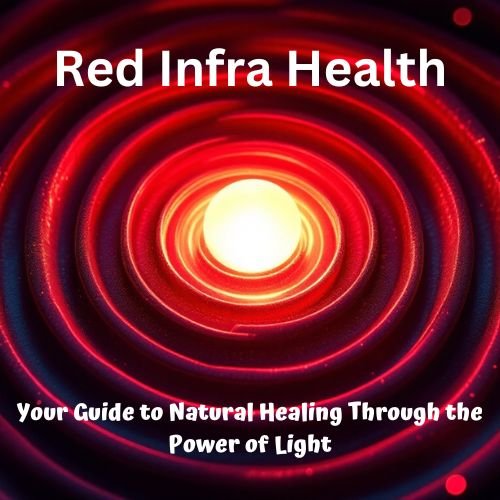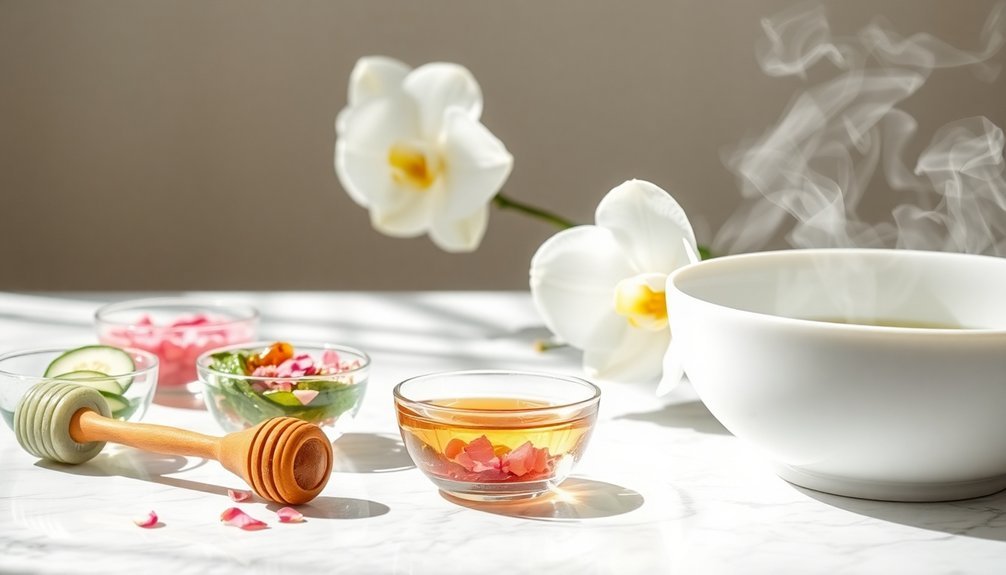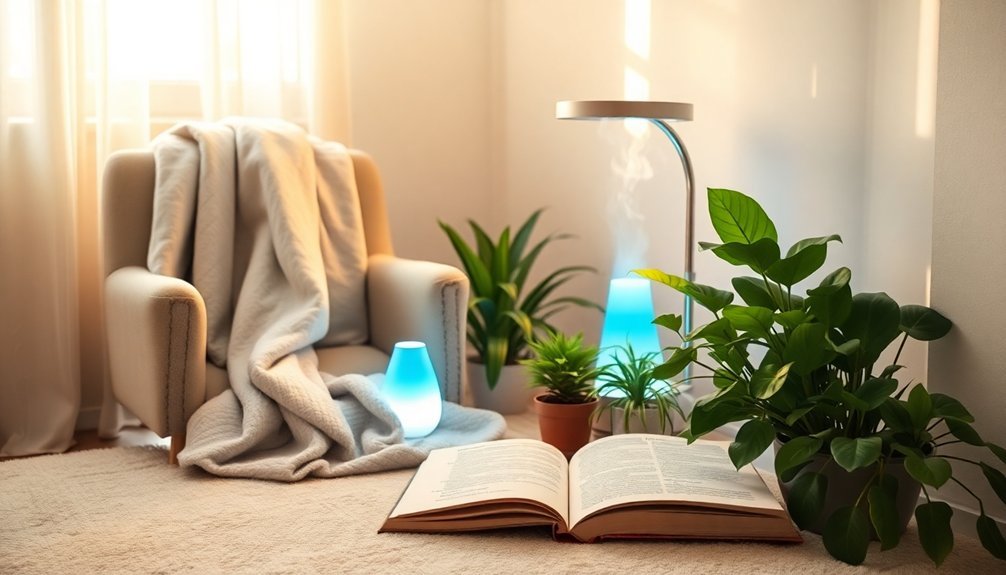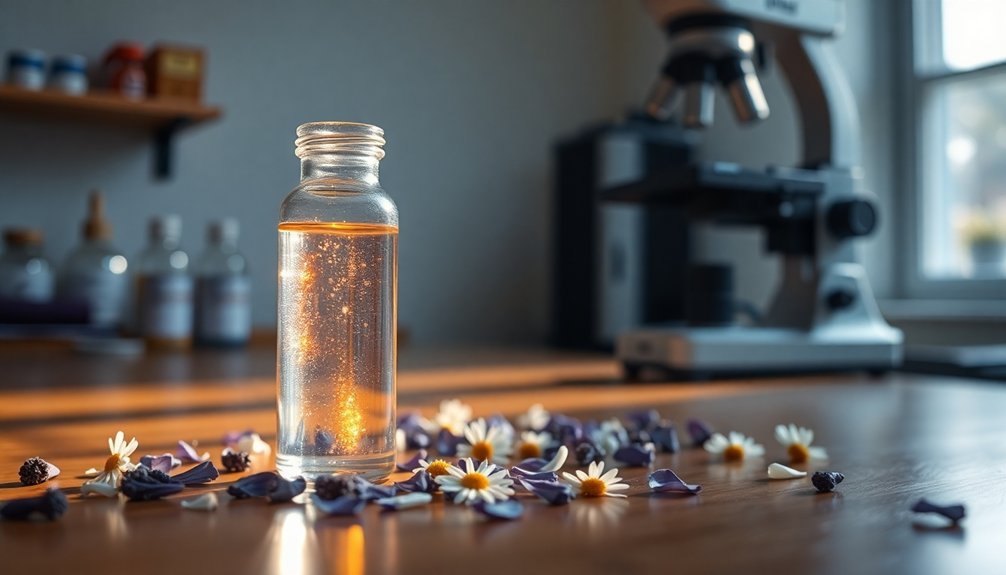You can naturally boost collagen production and sculpt your skin at home through a combination of proven techniques. Start with infrared and red LED light therapy sessions for 10-20 minutes daily, which penetrate deep into your skin to activate fibroblasts and increase ATP production. Support these treatments by incorporating collagen-rich foods, vitamin C sources, and antioxidant-packed ingredients into your diet. Enhance results with gentle facial massage, targeted exercises, and evening recovery rituals using botanical serums and RF devices. Your journey to firmer, more youthful skin continues with advanced strategies that transform your skin from within.
Understanding Infrared Light Benefits

Light waves hold remarkable healing properties, particularly in the infrared spectrum. When it comes to skin rejuvenation, infrared light penetrates up to two inches below your skin's surface, triggering profound changes at the cellular level. This deep penetration stimulates your body's natural collagen production by activating fibroblasts, the cells responsible for creating this essential protein.
Clinical research shows significant skin improvements after 12 weeks of consistent infrared therapy use. You'll notice several immediate and long-term benefits from infrared light therapy. Your skin becomes noticeably softer and more elastic, while wrinkles and crow's feet begin to diminish.
The therapy enhances blood circulation by dilating your blood vessels, which means better nutrient delivery to your skin cells. This increased blood flow also supports your body's natural detoxification process, with infrared-induced sweat carrying up to 20% more toxins than traditional sauna sessions.
What makes infrared light particularly effective is its ability to trigger anti-inflammatory responses in your body. It accelerates cell renewal and tissue repair, leading to faster skin rejuvenation.
The ideal wavelengths stimulate anti-inflammatory cytokines, reducing inflammation while promoting healthier, more resilient skin that looks naturally younger.
Skin Deep Cellular Repair
Your skin's dermal matrix naturally rebuilds itself through a complex network of collagen and elastin fibers that you can actively support through targeted treatments.
When you activate your skin's natural healing pathways through techniques like microneedling or aloe vera application, you're triggering a cascade of regenerative processes at the cellular level.
You'll boost cellular turnover by combining these methods with proper nutrition and protection, allowing your skin to maintain its structural integrity while producing fresh, healthy cells.
This regenerative process follows the body's three healing stages, beginning with inflammation, moving to proliferation, and ending with maturation for optimal skin repair.
Dermal Matrix Regeneration Basics
The complex process of dermal matrix regeneration boils down to a remarkable two-layer system that kickstarts your skin's natural healing abilities.
Your skin's matrix consists of two essential components: a dermal layer made of bovine collagen and chondroitin-6-sulfate, and a protective silicone layer that controls moisture and heat.
When you're dealing with deep skin concerns, your dermal matrix needs specific conditions to regenerate properly. The process typically takes 2-3 weeks, during which new cells infiltrate the matrix while blood vessels form to support healing. Traditional healing methods often result in heavy scarring and contractures that can limit mobility.
You'll find that this systematic approach leads to better skin quality and reduced scarring compared to traditional treatments.
Your skin's natural regeneration process relies heavily on the scaffold provided by these dermal templates. Think of it as building a new foundation for your skin cells to thrive.
The matrix gradually breaks down as your own tissue takes over, minimizing complications while maximizing results. While this technology was initially developed for serious burns and wounds, it's revolutionized our understanding of how your skin naturally heals and regenerates, leading to improved treatments for various skin concerns.
Natural Healing Pathway Activation
Natural healing pathways in your skin operate through an intricate network of cellular signals that coordinate repair at multiple levels. Your body's vitamin D system plays a critical role by stimulating keratinocyte growth and enhancing skin barrier function, while also activating essential stem cells that regenerate damaged tissue. The epidermal permeability barrier depends on a precise mixture of ceramides, cholesterol, and fatty acids to maintain optimal skin health.
You'll find multiple types of stem cells working together to heal your skin. Epidermal stem cells in the basal layer continuously renew surface cells, while hair follicle stem cells migrate to assist in wound repair. Mesenchymal stem cells are particularly powerful, as they promote blood vessel formation and help remodel collagen while calming inflammation.
Your skin's healing process relies heavily on specific signaling pathways. The PI3K/AKT pathway drives cell growth and differentiation, while the Wnt/β-catenin system regulates stem cell activity.
Your body also uses lipid signals to fine-tune the healing process. These natural fat-based molecules help control collagen production and prevent excessive scarring. They work through specialized mediators like PGE2, which helps limit fibrosis and promotes healthy tissue formation.
Cellular Turnover Boost Techniques
Boosting cellular turnover requires a strategic combination of exfoliation methods and targeted treatments to accelerate your skin's natural renewal process. You'll want to start with gentle exfoliation using either chemical agents like AHAs and BHAs or physical methods such as soft scrubs and brushes to remove dead skin cells effectively.
Incorporate key ingredients that support cellular regeneration into your routine. Retinoids work to increase cell turnover while promoting collagen production, while niacinamide and vitamin C enhance skin repair and protect against environmental damage.
For the best results, pair these with vitamin E and alpha-lipoic acid to support your skin's natural healing mechanisms.
You can amplify these effects by adding professional-grade treatments to your regimen. Red light therapy penetrates deeply to stimulate cellular repair, while focused ultrasound and microdermabrasion provide intensive exfoliation and collagen stimulation.
These techniques work with your skin's epidermal stem cells, which naturally regenerate tissue layers. For maximum impact, maintain a consistent routine that combines daily skincare with periodic intensive treatments, allowing adequate time between sessions for your skin to properly regenerate.
Natural Collagen Production Methods

You'll boost your skin's natural collagen production by incorporating protein-rich foods, vitamin C-packed fruits, and zinc-loaded nuts into your daily diet.
Your skin will benefit from gentle daily facial massage techniques that stimulate blood flow and enhance collagen synthesis naturally.
Adding collagen-boosting herbs like gotu kola and horsetail to your routine can further support your body's ability to maintain healthy, resilient skin.
Diet Powers Skin Health
Powering up your skin's natural collagen production starts with what's on your plate. Your body needs specific nutrients to maintain and boost collagen synthesis, and you'll find them in a variety of whole foods.
Start by incorporating bone broth into your diet – it's packed with ready-to-use collagen and essential minerals that support your body's natural production process.
You'll want to focus on protein-rich foods that provide vital amino acids like glycine, proline, and lysine. Include fatty fish, red meat with connective tissue, and eggs in your meals.
Don't forget to pair these with vitamin C-rich foods like citrus fruits, bell peppers, and strawberries, as they're essential for collagen synthesis.
Add nuts and seeds to your daily routine for their zinc and copper content, which actively support collagen formation.
To maximize your skin's collagen production, include a variety of collagen-boosting minerals in your diet. You'll find zinc in shellfish and dairy, copper in organ meats, and manganese in green vegetables and tea.
Remember to protect your existing collagen by consuming vitamin E-rich foods like avocados and leafy greens, which act as protective antioxidants.
Daily Facial Massage Benefits
Facial massage delivers five key benefits that naturally boost collagen production. When you incorporate daily massage techniques, you'll stimulate increased blood flow to facial tissues, promoting cell renewal and enhancing your skin's natural collagen production.
The gentle pressure relaxes facial muscles, helping prevent wrinkles while improving the absorption of your skincare products.
Through consistent massage, you're activating your lymphatic system, which helps decongest your skin and reduce puffiness. You'll notice improved elasticity as the massage techniques work to tone and lift your facial muscles.
The mechanical stimulation sends biological signals that trigger increased collagen and elastin production, particularly beneficial after age 40 when skin naturally begins to slacken.
To maximize these benefits, focus on strong, circular motions along your jawline, nose sides, and forehead. You'll want to apply firm but gentle pressure while massaging in your serums and creams.
For the best results, maintain a regular massage routine and consider consulting with a skincare professional to perfect your technique. This ancient practice, rooted in traditional Chinese medicine, continues to prove its worth through modern scientific validation.
Herbs Boost Collagen Production
From ancient Chinese medicine to modern botanical research, specific herbs have proven their ability to boost natural collagen production. You'll find potent collagen-boosting compounds in herbs like Tremella mushroom and goji berries, which contain essential polysaccharides and antioxidants that support your skin's natural elasticity.
Chinese Angelica root and Astragalus work synergistically to enhance collagen synthesis through their rich phytoestrogen and flavonoid content.
When you're looking to strengthen your skin's structure, consider Gotu Kola, which specifically targets stretch marks and improves skin thickness.
Traditional adaptogenic herbs like ginseng and He Shou Wu don't just boost collagen production; they also protect existing collagen by reducing the activity of collagen-degrading enzymes. You'll maximize these benefits by combining them with vitamin C-rich herbs such as thyme and moringa.
For exhaustive skin support, incorporate silica-rich herbs like horsetail and marshmallow into your routine. These herbs work alongside nutrients like zinc and amino acids to provide your body with the building blocks it needs for thorough collagen synthesis.
Calendula and hibiscus offer additional benefits through their cellular protection and gentle exfoliation properties.
At-Home Light Therapy Guide
While professional light therapy treatments offer powerful results, at-home light therapy devices have revolutionized the way we approach skin rejuvenation and collagen production.
Using specific wavelengths of light, these devices penetrate deep into your skin to stimulate cellular activity and boost collagen synthesis.
You'll find several types of light therapy options for home use. Red light therapy, which uses red and near-infrared wavelengths, effectively reduces inflammation while promoting collagen production. LED light therapy offers various wavelength options to address different skin concerns, from fine lines to uneven texture.
When choosing an at-home device, consider FDA-cleared options like the ReVive Clinical XL LED Light Therapy system. While these devices aren't as powerful as professional treatments, they're safe, convenient, and require no downtime.
You'll need to use them more frequently – typically 10-20 minutes daily or several times weekly – to achieve ideal results.
Remember that consistency is key with at-home light therapy. While professional sessions might only require maintenance every 4-6 weeks, your at-home device should become part of your regular skincare routine to maintain collagen stimulation and skin rejuvenation benefits.
Dermal Remodeling Techniques

Modern dermal remodeling techniques have stepped up to revolutionize collagen restoration in aging skin. You'll find cutting-edge treatments like micro-needling and radiofrequency that target your skin's deeper layers, stimulating natural collagen production and improving elasticity without invasive surgery.
If you're considering dermal remodeling, you've got several effective options. Treatments like Morpheus 8 combine micro-needling with radiofrequency to deliver facelift-like results, while Forma offers a gentler approach to skin tightening.
You'll typically see results within 4-6 weeks, and there's minimal downtime involved.
To enhance your treatment's effectiveness, you'll want to incorporate collagen-boosting strategies into your daily routine. Apply topical treatments containing peptides like Palmitoyl Tripeptide-3, and boost your diet with vitamin C-rich foods.
Don't forget to protect your investment by avoiding collagen-depleting habits like smoking and excessive sun exposure.
Before starting any treatment, consult a dermatologist to determine the best approach for your skin type. They'll help you develop an extensive plan that might include at-home maintenance with red light therapy and appropriate skincare products to maintain your results long-term.
Light Wavelength Impact Analysis
Light wavelengths hold the key to understanding how different therapies affect your skin's layers. When you're choosing light therapy for collagen production, you'll need to match specific wavelengths to your skincare goals. The deeper you need to target, the longer the wavelength you'll require.
| Wavelength Type | Penetration Depth | Primary Benefits |
|---|---|---|
| Blue Light (450-495nm) | Surface Layer | Kills bacteria, reduces acne |
| Red Light (620-750nm) | Mid-Dermis | Boosts collagen, reduces inflammation |
| Near-Infrared (800-2500nm) | Deep Tissue | Enhances cellular metabolism |
| Combined Therapy | Multiple Layers | Extensive skin rejuvenation |
You'll see the most dramatic collagen-boosting results with red light in the 630-680nm range, which directly stimulates fibroblast activity in your dermis. If you're using an at-home LED device, you'll want to focus on combinations of red and near-infrared wavelengths for maximum impact. These wavelengths work together to enhance cellular regeneration while promoting deeper tissue healing. Your skin's thickness and melanin content will influence how effectively the light penetrates, so you may need to adjust treatment duration accordingly.
Daily Treatment Protocol

Your morning ritual begins with topical vitamin C application and collagen peptide supplementation, followed by UV protection to shield your skin's collagen fibers throughout the day.
In the evening, you'll focus on recovery by applying retinoids and performing targeted treatments like LED light therapy or RF device sessions to stimulate collagen production.
These morning and evening protocols work together to protect existing collagen while encouraging your skin's natural ability to generate new collagen fibers.
Morning Ritual Steps
Starting each morning with a purposeful collagen-boosting ritual can transform your skin's health and appearance over time. You'll want to begin by incorporating a high-quality collagen protein powder into your morning beverage, whether it's your coffee or a nutrient-rich smoothie.
This supplementation works best when combined with collagen-supporting foods like vitamin C-rich fruits and leafy greens.
- Begin with a gentle facial massage using an oil cleanser to reduce morning puffiness and stimulate blood flow.
- Perform targeted facial exercises 3-4 times weekly to enhance natural collagen production.
- Track your progress consistently to stay motivated and adjust your routine as needed.
Next, focus on your nutritional intake by including collagen-rich foods in your breakfast, such as eggs or bone broth. You'll want to avoid excess sugar and refined carbohydrates, which can hinder collagen synthesis.
Make your morning ritual as seamless as possible by preparing ingredients the night before. Remember to approach this routine with patience and consistency – treating it like brushing your teeth will help you maintain the habit and achieve noticeable improvements in your skin's elasticity and overall appearance.
Evening Recovery Techniques
The evening hours provide an ideal window for collagen-boosting recovery, complementing your morning ritual with targeted treatments that work while you rest. You'll maximize collagen production by incorporating a combination of non-invasive therapies and natural treatments into your nighttime routine.
Start with a warm collagen drink mixed with calming spices, then move on to your LED light therapy session. You'll enhance results by following up with radio frequency treatment using devices like NEWA RF, which stimulates both collagen and elastin production. Don't forget to include botanical serums rich in antioxidants before your final steps.
| Treatment Type | Duration | Benefits |
|---|---|---|
| Red Light Therapy | 10-15 mins | Cellular regeneration |
| RF Device | 5-8 mins/area | Collagen stimulation |
| Facial Massage | 3-5 mins | Circulation boost |
| Botanical Serum | Overnight | Skin rejuvenation |
For best results, you'll want to maintain consistency with your evening protocol. Consider incorporating wild mushroom-based masks twice weekly, and don't skip your nightly acupressure massage using herbal compresses. Remember to allow adequate time between different treatments, especially when using electronic devices.
Optimal Treatment Duration
Understanding ideal treatment duration is essential when pursuing natural collagen revival, as different treatments require varying time commitments and frequencies. Microneedling demands 4-6 monthly sessions lasting 20 minutes each, while Sculptra treatments span 30-45 minutes per session over 2-4 visits spaced 4-6 weeks apart.
Your at-home care routine forms the foundation of any collagen-boosting regimen:
- Daily protection with broad-spectrum sunscreen prevents collagen breakdown
- Weekly exfoliation (1-3 times) promotes natural skin renewal
- Regular moisturizing masks enhance hydration and skin barrier function
For professional treatments, you'll need to commit to specific maintenance schedules. Microneedling requires touch-ups every 2-3 months, while Sculptra results can last up to two years before needing maintenance.
Laser treatments vary in duration based on the treated area but typically need multiple sessions spaced weeks apart. You'll notice that each treatment's longevity depends on your dedication to aftercare and protection from environmental factors.
Remember to complement any professional treatment with consistent at-home care, including daily moisturizing and proper sun protection to maximize and maintain your results.
Combining Therapies for Results

Combining multiple collagen-boosting approaches yields remarkably better results than relying on a single treatment method. You'll achieve the best results by integrating dietary, topical, and therapeutic treatments into your skincare routine.
Start by incorporating collagen-rich foods and supplements into your diet, including marine collagen and vitamin C-rich foods. Complement this with hydrating ingredients like berries and leafy greens that naturally contain hyaluronic acid.
For topical application, use products containing retinoids and niacinamide, which work synergistically to stimulate collagen production and reduce inflammation.
You can enhance these foundational treatments with at-home devices like the Anteage Growth Factor Roller or LED light therapy at 630nm wavelength. Consider adding facial massage techniques to improve blood flow and stimulate fibroblasts.
For even better results, combine these methods with professional treatments like microneedling or ultrasound therapy.
Create a thorough routine by using glycolic acid formulations and chemical peels to promote cell turnover, while maintaining skin hydration with natural ingredients like almond and milk packs. This multi-faceted approach guarantees you're targeting collagen production from multiple angles, maximizing your skin's rejuvenation potential.
Long-Term Maintenance Strategies
Maintaining healthy collagen levels requires a thoroughgoing, long-term commitment that goes beyond short-term treatments. You'll need to adopt a detailed approach that combines daily habits, dietary choices, and protective measures to sustain your collagen production naturally.
- Prioritize sleep hygiene and stress management, as poor sleep and high cortisol levels can markedly diminish your body's collagen synthesis.
- Incorporate collagen-supporting nutrients through protein-rich foods and vitamin C sources while limiting AGE-rich processed foods.
- Protect your existing collagen by using sun protection daily and avoiding environmental stressors that accelerate breakdown.
Your lifestyle choices play a vital role in preserving collagen levels. Make exercise a non-negotiable part of your routine, focusing on resistance training to stimulate collagen production.
Don't underestimate the power of nutrition – see to it that you're getting adequate protein, vitamins, and minerals through whole foods.
Stay consistent with your skincare routine, using products containing retinol or other collagen-boosting ingredients.
Remember that damage prevention is just as important as active treatment, so maintain sun protection and avoid harmful habits like smoking that can rapidly deplete your collagen stores.
Frequently Asked Questions
Can Certain Medications Interfere With Collagen Production Treatments?
Yes, your medications can interfere with collagen production. Oral and topical steroids, statins, blood thinners, and certain heart medications can reduce collagen synthesis and affect treatment outcomes. Always inform your doctor beforehand.
How Does Hormonal Imbalance Affect Natural Collagen Production?
Your hormonal imbalance, especially low estrogen levels, can substantially decrease your natural collagen production, leading to thinner skin, reduced elasticity, and more wrinkles. It'll also affect your fibroblasts' ability to produce collagen.
Are There Specific Sleeping Positions That Can Prevent Collagen Breakdown?
Sleep on your back to minimize collagen breakdown. You'll prevent sleep lines and improve circulation. If you're a side sleeper, use silk pillowcases and alternate sides to reduce facial pressure and wrinkles.
Does High-Altitude Exposure Impact Collagen Production Differently Than Sea Level?
Yes, you'll experience reduced collagen production at high altitudes due to increased UV exposure and lower oxygen levels. Research shows decreased collagen gene expression and fiber content compared to sea level environments.
Can Excess Exercise Negatively Affect Collagen Synthesis in Facial Tissues?
Yes, if you over-exercise, you'll risk chronic inflammation and stress that can impair facial collagen production. Excessive workouts without proper recovery can also disrupt hormonal balance, negatively affecting your skin's collagen synthesis.
In Summary
You're now equipped to boost your skin's natural collagen production through at-home dermal sculpting. By incorporating infrared light therapy and proper treatment protocols into your daily routine, you'll see gradual improvements in skin texture and firmness. Remember to maintain consistency with your chosen techniques and combine multiple approaches for best results. Your commitment to these natural methods will reward you with lasting skin rejuvenation.





Leave a Reply